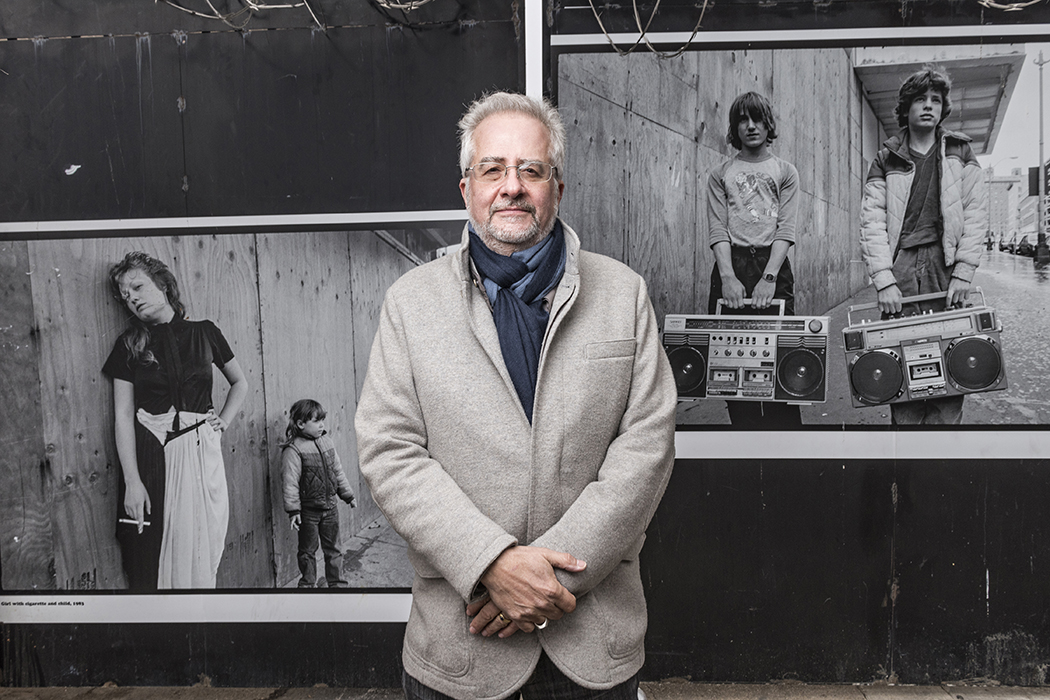
Alan Govenar stands in front of The Museum of Street Culture’s first instillation. (Photo by Danny Fulgencio)
Community Curator
When driving toward Downtown on Columbia, neighbors might notice what appears to be an old fire station, its brick façade recalling a bygone era. But the structure hasn’t been Fire Station No. 16 since 1978. Instead, it served East Dallas as a community arts center, museum and is now a studio.
Alan Govenar and his wife, Kaleta Doolin, acquired the property in 1991, when a Mexican Mennonite church community worshipped there. The couple restored the building with architect Dan Shipley and worked to establish it as a Dallas Landmark on the National Register. They planted trees and created an artistic oasis in East Dallas.
The former fire station became 5501 Columbia Art Center to exhibit photography, paintings and sculptures. Next, the couple obtained other properties in the area. One became the Texas African American Photography Archive, which housed more than 60,000 images taken between 1840 and 2000. Doolin established the “Art in Community Program” and provided a space for Aguila Azteca, a boxing gym for kids in the neighborhood. There is also an adjacent home for an artist in residence.
“East Dallas is definitely part of our life,” says Govenar, who splits his time between New York and his East Dallas office. The couple does more than rehabilitate East Dallas properties. The former fire station – complete with fire poles – is used today as a studio and office for Govenar, a filmmaker, photographer and author of 29 books, and for Doolin, an artist and arts advocate. Today Govenar operates Documentary Arts Inc., a nonprofit arts organization, in the space.
In the past, Govenar organized music festivals in Dallas, wrote numerous books about the Texas blues, African American photography and made a film called “Stoney Knows How” about a circus and carnival sideshow tattoo artist, which was an Outstanding Film of the Year at the London Film Festival. “It is an inside look at a hunchback dwarf tattoo artist in a wheelchair,” he says.
Govenar’s latest project as the founding director of The Museum of Street Culture is a collaboration between First Presbyterian Church and The Stewpot, which provides resources, programs and social services for the homeless. The museum’s mission is to activate social change and community through art and education by displaying the everyday experience of people in public places.
The museum will display work by professionals and Stewpot clients within the facility as well as on the street, adding art and beauty to an area where many of the clients congregate. In addition, the Stewpot trains clients to be docents, leading groups visiting the works.
“The Museum of Street Culture will be on the street and about the street,” Govenar says.
Currently, the museum showcases the work of Mary Ellen Mark, an award-winning photographer who documented a teen runaway in Seattle for 32 years. On Jan. 27, the museum will feature work done by children in the Saturday Kid’s Club, a program run by the Stewpot for at-risk children. “We are reinventing the museum,” Govenar says.
The museum is part of a larger development called Encore Park, a nonprofit pioneered by First Presbyterian Church. It is a community of social and cultural services that includes an amphitheater, community garden and 508 Park, a 1929 building where Bob Wills and Robert Johnson made records. 508 Park eventually will be an event space, recording studio and a showcase for art programming.
The connection between music, homelessness and the museum is not lost on Govenar. “Vernacular music was all about giving a voice to the voiceless,” he says. “Many of the musicians would have been homeless if not for the music.”
Govenar considers his latest endeavor an extension of his past work and a way to make a difference.
“The Museum of Street Culture is about rethinking the modes of presentation,” he says. “We are trying to humanize one of the most marginalized groups. Being homeless is not an identity. It’s a circumstance.”





